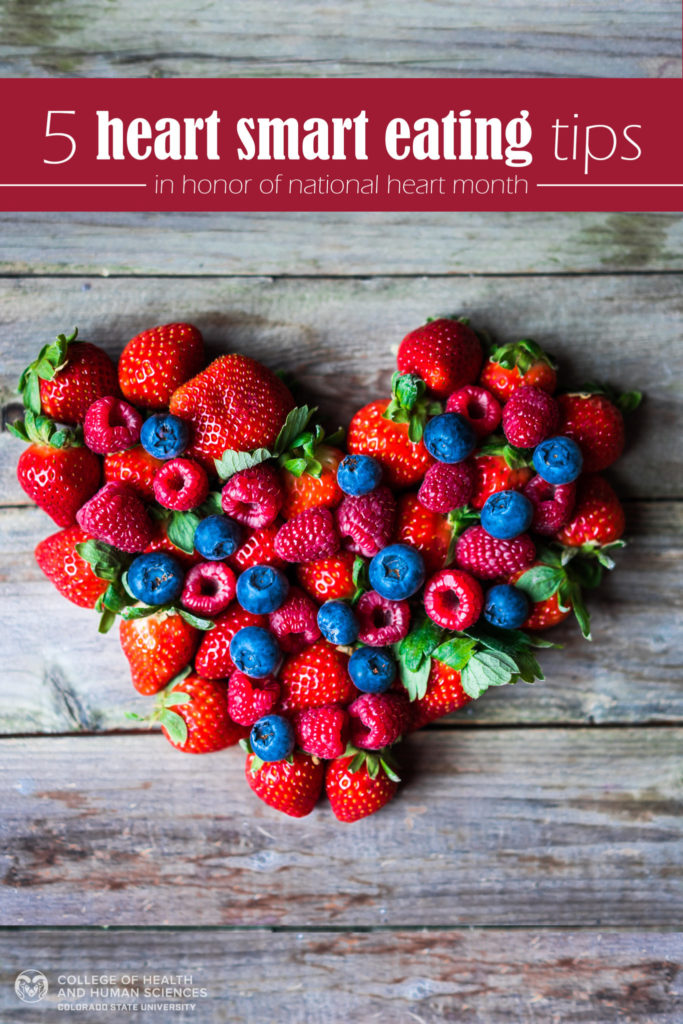In popular media and diets, nutrition tends to take a negative light—“don’t eat that”, “this food is bad”, “10 foods to avoid”—focusing on restriction, deprivation and outright elimination. Sure, the intention of these messages is to ultimately protect health, but all this stress around eating can actually sabotage our health, including our heart health. There is a connection between stress and heart disease, and stress surrounding eating can be a contributor.
To honor national heart month, let’s shift from a negative “removal” approach to heart-smart eating and instead look at health through a positive “eat more of these foods” lens.
Fill Your Plate with Fruits & Vegetables
Fruits and vegetables contain vitamins, minerals, fiber, antioxidants and other phytochemicals that protect the heart from many angles. Plant foods provide fiber that helps lower cholesterol and phytochemicals that defend against inflammation. A good rule of thumb is to fill half your plate with fruits and vegetables, the more variety and color, the better. Leave on skins, peels and include the seeds (when sensible) for added nutrition. Fruits and vegetables don’t have to be raw and fresh, frozen varieties are versatile, inexpensive and also very nutritious.
Tip: Start by looking for opportunities to mix fruits and vegetables into meals you already routinely make. Oatmeal for breakfast? Add a scoop of frozen berries or sliced banana. Lasagna, pizza or enchiladas for dinner? Add shredded carrots, mushrooms, zucchini, chopped spinach or peppers.
Serve up Seafood Twice a Week
Studies have shown a pattern between people who eat seafood and lower risk of heart disease. Seafood is a good source of protein and omega-3 fatty acids—heart-healthy fats that can lower triglyceride levels and blood pressure while protecting from plaque growth. Good options include salmon, tuna, mackerel and sardines, but all seafood contains omega-3 fatty acids. Aim to eat two 4-ounce servings of fish/seafood each week.
Tip: Canned salmon is less expensive than fresh, just as versatile as canned tuna, and is packed with protein and omega-3 fatty acids. Canned salmon can be used to make easy sushi bowls (mix with favorite hot sauce, sesame oil, green onions, jalapeno, avocado and serve over rice) or doctored up for quick fish tacos (salsa, cabbage slaw, guacamole, corn tortillas).
Pick Plant Fats
Heart-healthy plant fats including olive oil, canola oil, flaxseed oil, peanut oil, nuts, seeds and avocados can help to lower blood cholesterol and promote overall health. These fats are especially beneficial if they are used to replace saturated fats (the fats found in fried foods and animal products including bacon, butter, cream, cheese and more). Be cautious of marketing claims and fads focusing on coconut oil (technically a plant fat), which is actually considered a saturated fat. Palm oil, another tropical oil commonly found in processed foods, is also considered a saturated fat.
Tip: Make your own salad dressing by mixing olive oil with any combination of lemon juice, garlic, herbs, balsamic vinegar, red wine vinegar and Dijon mustard.
Switch to Whole grains
Make at least half of your grains whole grains. Try to eat whole grain foods every day, including whole wheat breads and pastas, brown rice, wild rice, oatmeal, quinoa and barley. The less processed the grain, the more fiber intact, which in addition to lowering cholesterol, can help promote satiety and gut health. Weight management and gut health play an important role in heart health.
Tip: Start by making simple switches in your current routine—trade white rice for brown rice, white bread for whole wheat bread, white pasta for whole wheat pasta, quick-cook oatmeal for steel-cut oats. When looking at nutrition labels, pick products that use the word “whole” in the first ingredient. “Multi-grain” does not mean “whole grain”.
More Meatless Meals
By eating more plant-based meals, you naturally boost the fiber content in your diet while also reducing saturated fat. Beans, nuts, seeds, lentils, legumes and soy foods can be used to supplement or substitute meat in a dish. These lean plant-based proteins have the added bonus of being less expensive than animal products, but just as protein-rich (and delicious!).
Tip: Start by mixing plant proteins into dishes you routinely make. For example, if you’re making burgers, tacos or chili, mix ground meat with beans, lentils, soy crumbles or chopped walnuts.
Instead of focusing on cutting foods out of your diet, emphasize these nourishing foods in your meals. Small changes overtime will add up to big benefits for your health. Stress-free eating is remembering that all foods can fit into a healthy eating pattern—and that it’s what you eat the majority of the time that matters most. With this positive approach to heart-healthy eating, it’s important to still keep tabs on added sugars/sweeteners, sodium and saturated and trans fats, but the hope is that these nutrients get displaced when we take a “Eat-more-healthy-foods” approach.
There is no one-size-fits all nutrition plan for healthy eating. Nutrition needs are unique to each individual and are based on energy needs, health conditions, age, sex and more.
Story by Kalyn Garcia, MS, RDN
For delicious recipes, nutrition tips, and to find cooking and nutrition classes, go to the Kendall Reagan Nutrition Center website. More great info is also available at the College of Health and Human Sciences Pinterest board.